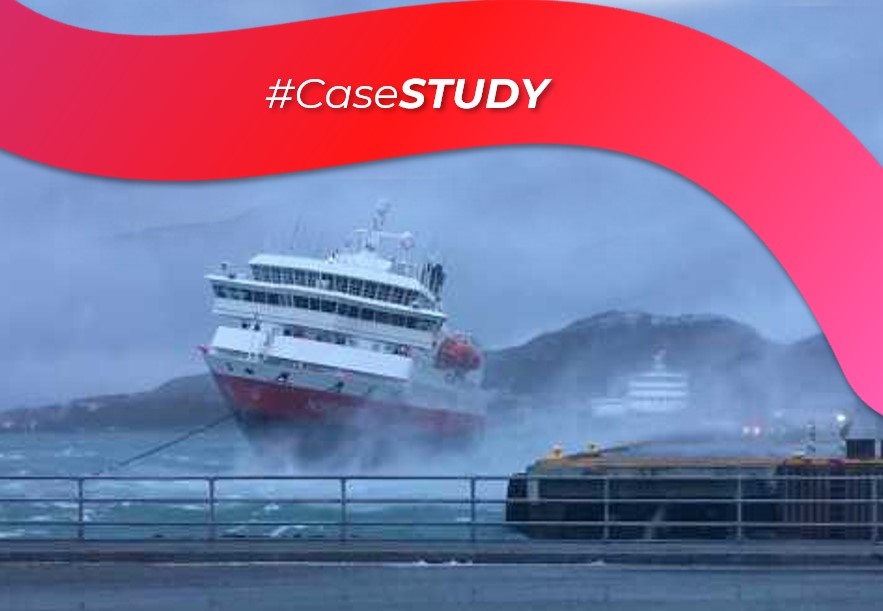
The Freed Dolphin’s Mystery
The incident took place at the Cruise Terminal of Puerto ‘Dos Bocas’, Mexico. At the material time of occurrence Harbor Authorities have issued a ‘Hurricane Warning’. Contrary to the typical ‘striking with fixed objects’ cases, in this particular case, there was no striking between the ship and port fixed structures. Strangely though, one of berth’s dolphins was literally ‘detached’ from its position, removing the whole structure from its concrete pillars. Appointed investigators yielded three potential causes:
a) Pre-existing wear and tear on the dolphin.
b) Previous unreported incidents weakening the dolphin’s structure.
c) Unsafe mooring practices.
The Berth:
Puerto Dos Bocas Terminal is located in a relatively sheltered area, offering berthed ships considerable protection from wind and tidal forces. During Hurricane Season, coastal authorities would intensify warnings and notices to mariners, following up every 6 hours. The standard practice is that large ships avoid staying at berth during a Hurricane Warning. Warnings issued prior to the incident recommended all large ships to sail away if possible, remaining in the waiting areas outside Dos Bocas Harbor. The ship, however, decided to stay moored at the berth.
Dolphin’s condition prior to the incident:
Investigations revealed that the ill-fated dolphin had no significant incidents in the previous 12 months, having gone through regular maintenance and approval by Harbor Authorities a few months before the event. On-site surveys further confirmed no consistent evidence of material fatigue.
Mooring Practices:
The importance of safe mooring operations in maritime activities, particularly for large vessels such as cruise ships, is critical. Broken mooring lines can cause severe incidents (for instance, collisions or striking with objects), leading to significant damage, pollution, and even loss of life. What are the key factors contributing to mooring line failures? Essentially, inadequate planning, unsafe distribution, and a lack of inspection and maintenance.
Large passenger ships, such as cruises, have tall and large superstructures, making them vulnerable to the pressure exerted by wind forces (alongside nominal tidal forces prevailing in the area). These forces have a direct impact on the setting of the mooring lines. According to SOLAS (International Convention for the Safety of Life at Sea) regulations and recent amendments effective from January 1, 2024, a suitable Mooring Arrangement Plan must take into consideration -among others- prevailing weather conditions and warnings issued by the Coastal Authority, the status of maintenance of mooring lines in accordance with manufacturers’ guidelines, and safe practices such as regular
inspections by crew members.
The Negotiation:
Having ruled out material fatigue and maintenance issues, our attention turned to the mooring arrangements. It was later discovered that the distribution of mooring lines was inadequate, resulting in imbalanced pressure on different parts of the ship. Even in relatively calm conditions, the ship faced additional pressure from nominal currents and onshore winds. The investigation also questioned why the mooring lines did not break, considering their design break force.
The combined effect of the unbalanced distribution of the existing lines and the lack of monitoring by the crew led to excessive pressure in the most westerly located dolphin, detaching it from its concrete pillars.
Conversely, instead of conducting a thorough survey or even requesting, owners’ intervention was solely limited to delivering a statement before Coastal Authorities. According to the master’s statement, mooring was conducted as per ‘standard practice and good seamanship’. At some point, said statement was simply not enough to provide evidence of a safe Mooring Arrangement Plan.
In tortious claims, once damage and causation are established, the burden shifts to defendants to demonstrate their due care. In this case, the owners failed to prove the adequacy of the Mooring Arrangement Plan, crew monitoring, or any possible cause relieving them of liability related to the loss. From the standpoint of recovery, the owners were faced with at least an arguable case of lack of due care, in the face of which, an out-of-court settlement was a better option.
This incident highlights the importance of investigating surrounding circumstances when faced with unexplained losses. Understanding risk allocation and conducting detailed assessments can lead to successful recovery strategies.
BARBUSS
Case Study by

Tomás Appleyard
Recovery Manager
Un incidente reciente en la Terminal de Cruceros de Puerto ‘Dos Bocas’, México, suscitó un reclamo de parte de nuestro cliente debido a las implicancias por el bienestar de un cabo de amarre. Esto ocurrió durante un período en el que el puerto estaba bajo una ‘Alerta de Huracán’, aunque las condiciones climáticas tuvieron poco efecto en el barco o en su muelle. Curiosamente, mientras el barco en sí no sufrió daños, un cabo de amarra fue desalojado de sus pilares, dejando el muelle inutilizable durante tres semanas. Las investigaciones sobre el incidente arrojaron tres posibles causas:
a) Desgaste previo en el cabo de amarre.
b) Incidentes previos no reportados que debilitaron su estructura.
c) Prácticas de amarre inseguras.
El Muelle:
La Terminal del Puerto Dos Bocas está ubicada en una zona relativamente resguardada, ofreciendo a los barcos amarrados una considerable protección contra el viento y las fuerzas de la marea. Durante la temporada de huracanes, las autoridades costeras intensifican las advertencias y avisos a los navegantes, siguiéndolos cada 6 horas. La práctica estándar es que los barcos grandes eviten permanecer amarrados durante una advertencia de huracán. Las advertencias emitidas antes del incidente recomendaron que todos los barcos grandes zarparan si era posible, permaneciendo en las áreas de espera fuera del Puerto Dos Bocas. Sin embargo, el barco decidió quedarse amarrado en el muelle.
Condiciones del cabo de amarre antes del incidente:
Las investigaciones revelaron que el desafortunado cabo de amarre no tuvo incidentes significativos en los 12 meses anteriores, habiendo pasado por un mantenimiento regular y la aprobación de las Autoridades del Puerto unos meses antes del evento. Las pericias en el sitio confirmaron además que no había evidencia consistente de fatiga del material.
Prácticas de amarre:
La importancia de un amarre seguro en actividades marítimas, particularmente enfocadas en embarcaciones grandes como cruceros, es crítica, ya que resalta los riesgos asociados con líneas de amarre rotas, que pueden causar daños significativos, contaminación e incluso pérdida de vidas. ¿Cuáles son los factores clave que contribuyen a las fallas de las líneas de amarre?
Inadecuada inspección o de mantenimiento y preparación para las condiciones ambientales.
El barco en riesgo poseía una superestructura alta y grande, lo que lo hacía vulnerable a la presión del viento sobre sus líneas de amarre. De acuerdo con las regulaciones SOLAS (Convenio Internacional para la Seguridad de la Vida Humana en el Mar) y las enmiendas recientes efectivas a partir del 1 de enero de 2024, un Plan de Arreglo de Amarre adecuado requiere adherirse a las condiciones climáticas prevalecientes, mantenimiento de líneas de amarre, evaluación de condiciones ambientales y comunicación con Autoridades Costeras.
La Negociación:
Al descartar la fatiga material y los problemas de mantenimiento, la atención se centró en los arreglos de amarre. Se descubrió que la distribución de las líneas de amarre era inadecuada, lo que resultaba en una presión desequilibrada en diferentes partes del barco. Incluso en condiciones relativamente calmadas, el barco enfrentaba presión adicional de corrientes de resaca y vientos de tierra.
La investigación también cuestionó por qué las líneas de amarre no se rompieron, considerando su fuerza de rotura de diseño.
El efecto combinado de una distribución desequilibrada, falta de supervisión por parte de la tripulación y presión excesiva llevó al desprendimiento del cabo de amarre de sus pilares.
Tras el incidente, los propietarios optaron por alejarse sin llevar a cabo más pericias sobre el cabo de amarra dañado o proporcionar mayores declaraciones a las Autoridades Costeras locales.
No pudieron proporcionar pruebas consistentes con respecto a la distribución insegura de las líneas de amarre o la falta de supervisión de la tripulación, especialmente dada la ‘Alerta de Huracán’.
En reclamos accionables, una vez que se establece el daño y la causalidad, la carga recae en los demandados para demostrar el debido cuidado. En este caso, los propietarios no lograron demostrar la adecuación del Plan de Arreglo de Amarre, la supervisión de la tripulación o la ausencia de responsabilidad por el daño. Como resultado, se alcanzó un acuerdo razonable, mitigando tanto las pérdidas materiales como financieras.
Este incidente destaca la importancia de investigar las circunstancias circundantes cuando se enfrentan a pérdidas inexplicadas. Comprender la asignación de riesgos y realizar evaluaciones detalladas puede llevar a estrategias de recuperación exitosas.
